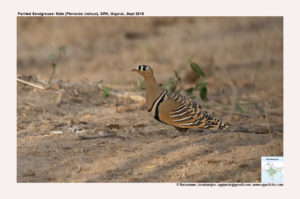Painted Sandgrouse

Painted Sandgrouse Pterocles indicus
Etymology:
- Pterocles :Greek word pteron -wing; kles – notable, splendid
- Indicus: From India
Vernacular names: Baluchistan: Gwadarg, Hindi: Paharibhatteetar, Bhatban, U.P.: Chapka, Gutilateetar,Guj: Rangeen/RangeetbatavdoPahadibatado, Kan: Palki, Kalgojalhakki, Mar: RangitPakhurdi
Distribution in India: Wide spread resident in India.
Description: Size of 28 cm .weight of 170–227 g. . It is a small, densely barred bird, with short tail and black and white pattern on head of males with characteristic design on wing-coverts. The male has a chestnut bar within pectoral band. The female has heavily barred breast and neck.. The female has dorsal marks more straight, not crescent-shaped, and darker belly. The bill is orange-brown; orbital ring is yellow. The juvenile are similar to adult female, even more densely streaked and barred.
Habitat: It is found in bare foothills and plateaux, sparsely covered with scrub or thorn bushes, forested country, at rocky ground, firelines and burnt areas.
Food habits: It eats seeds, some shoots and termites in certain seasons. It drinks water after dusk.
Breeding habits: They breed in Apr–Jun in India.The nest is a scrape among stones and earth, with little or no lining and commonly shaded by bush, tree or boulder. They lay a clutch of 2- 3 eggs.The incubation period is 21–23 days.